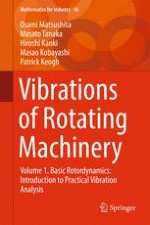2017 | Buch
Vibrations of Rotating Machinery
Volume 1. Basic Rotordynamics: Introduction to Practical Vibration Analysis
verfasst von: Prof. Dr. Osami Matsushita, Prof. Dr. Masato Tanaka, Prof. Dr. Hiroshi Kanki, Dr. Masao Kobayashi, Prof. Dr. Patrick Keogh
Verlag: Springer Japan
Buchreihe : Mathematics for Industry
